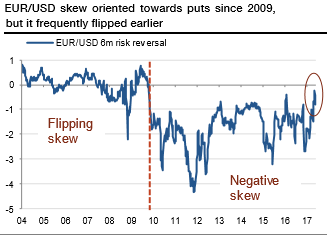EURUSD risk reversals (RR), which measure the relative appetite of upside and downside strikes, have been oriented towards puts since end-2009 (refer above graph). However, before 2009, EURUSD RR frequently flipped between calls and puts. A negative RR means that the US dollar tends to appreciate faster than it falls, reflecting the durable positive correlation between the dollar’s level and its volatility. This is what happened when the Fed embraced exceptional monetary easing. But the ongoing monetary switch, coupled with choppy exits in both the US and EU, could switch the dollar/vol correlation if the dollar declines in a disordered way. Indeed, EURUSD vega will perform if the terminal fed funds rate peaks lower than expected while the market discounts a tighter ECB, since the 6m vol is strongly correlated with the ECB vs Fed rates spread (refer above graph).
That would result in positive EURUSD risk reversals, or at least put an end to a persisting negative skew, with frequent flips from now on.
While the EURUSD skew stayed negative during the years of super-easy monetary policy, changes in FX skews are not unusual. For instance, the USDJPY 3m RR has traded on the positive side 23% of the time since start-2009, and the EURGBP 3m RR has been on each side exactly 50% of the time over the same period. The EURUSD 3m RR is currently nearly flat, while the 6m and 1y are lower than one vol for EUR puts. Crossing the line whereby euro calls become more expensive than puts may not be that far away.
With alleviating EUR downside risks, and given frequent flips in the EURUSD skew before the Fed/ECB QE era, positive EURUSD risk reversals are an increasingly likely development.



 Goldman Predicts 50% Odds of 10% U.S. Tariff on Copper by Q1 Close
Goldman Predicts 50% Odds of 10% U.S. Tariff on Copper by Q1 Close  Asian Fund Managers Turn More Optimistic on Growth but Curb Equity Return Expectations: BofA Survey
Asian Fund Managers Turn More Optimistic on Growth but Curb Equity Return Expectations: BofA Survey  Bank of America Posts Strong Q4 2024 Results, Shares Rise
Bank of America Posts Strong Q4 2024 Results, Shares Rise  U.S. Banks Report Strong Q4 Profits Amid Investment Banking Surge
U.S. Banks Report Strong Q4 Profits Amid Investment Banking Surge  China’s Growth Faces Structural Challenges Amid Doubts Over Data
China’s Growth Faces Structural Challenges Amid Doubts Over Data  Stock Futures Dip as Investors Await Key Payrolls Data
Stock Futures Dip as Investors Await Key Payrolls Data  Global Demand for Yuan Loans and Bonds Surges as China Pushes Currency Internationalization
Global Demand for Yuan Loans and Bonds Surges as China Pushes Currency Internationalization  U.S. Treasury Yields Expected to Decline Amid Cooling Economic Pressures
U.S. Treasury Yields Expected to Decline Amid Cooling Economic Pressures  European Stocks Rally on Chinese Growth and Mining Merger Speculation
European Stocks Rally on Chinese Growth and Mining Merger Speculation  Indonesia Surprises Markets with Interest Rate Cut Amid Currency Pressure
Indonesia Surprises Markets with Interest Rate Cut Amid Currency Pressure 






























